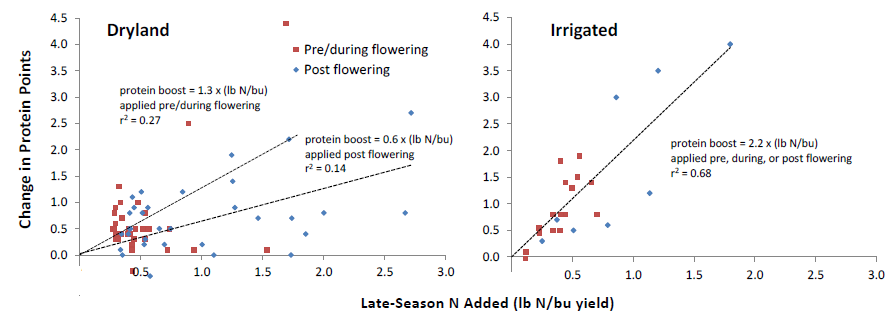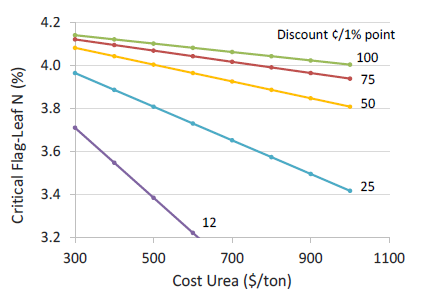N Management for Wheat Grain Protein
To produce high grain protein, there must first be enough nutrients to meet wheat’s needs for vegetative growth and grain yield (see Soil Scoop Nitrogen Management for Grain Yield). The management considerations for high protein are the same for all regions, but decisions should be based on guidelines specific to a grower’s area.
Rate
The standard rates for optimal yield and protein, along with site specific adjustments are presented in the Soil Scoops Nitrogen Management for Grain Yield and Fertilizer Rate Calculations.
Nitrogen fertilization practices can be evaluated by compiling several years of grain protein levels. If winter wheat protein is generally under 12.5%, then yield and protein have likely been N limited. Spring wheat grain protein under 13.2% indicates under-fertilization. To increase wheat protein by 1 point (percent) requires roughly an additional 0.75 lb N/bu of expected yield, applied before or during flowering in dryland production, and roughly an additional 0.45 lb N/bu yield, applied around flowering in irrigated production. Irrigated systems require less N per bushel because irrigation will result in most of the N ending up in the rootzone, whereas low precipitation in dryland can leave N stranded on surface.
If available N is not limiting, yet protein is low, there may be a sulfur (S) deficiency. This shows up first as yellowing upper (younger) leaves, whereas N deficiency shows up as yellowing lower (older) leaves. A foliar application of 3-5 lb S/acre in a sulfate form should correct the problem if there is sufficient rain or irrigation water after application to wash the sulfate into the root zone.
Source
Urea (46-0-0) is still the best choice if it can be incorporated by greater than ½-inch
of water in a single event. Treating urea or UAN (28-0-0 or 32-0-0) with N-butylthiophosphoric
triamide (NBPT, e.g., Agrotain®) can buy time for incorporation by precipitation, which may increase grain protein.
Slow or controlled release N fertilizers can be too
slow to benefit yield, but may increase protein. Legumes in rotation are an economical
N source and can benefit grain protein after just 1 or 2 rotations. Suggested legume
management to benefit wheat yield and protein is presented in the Soil Scoop Nitrogen Management for Grain Yield.
Timing
Nitrogen available to wheat plants after stem elongation has completed contributes directly to grain protein. Nitrogen applications after, rather than before, stem elongation have less chance of causing lodging. Urea or UAN to boost protein are ideally applied at flowering. This must be followed by irrigation or rain to move the fertilizer into the root zone. Hence the response to late-season N is more predictable under irrigation than dryland production (Figure 1). If there is high risk of scab, avoid watering, therefore N application, within 5 days of flower. In dryland production, the ability to incorporate late-season N with chance rainfall is more important than applying N at flowering; there is less risk and higher probability of protein response when N is applied between boot and the onset of flowering. Control or slow release N fertilizer is best seed placed to benefit wheat protein. Under irrigation they can be spring broadcast to benefit spring wheat protein.

Fig.1. Change in grain protein points in response to N per bushel of yield applied
pre/during flowering or after
flowering in dryland and irrigated production (EB0206).
Irrigated spring wheat grain protein is likely to increase with late-season N if the
flag-leaf N concentration is less than 4.2% (Fertilizer Facts No. 12). The critical
flag-leaf N (CFLN) is the flag-leaf N below which a late-season top-dress should
increase protein enough to maximize profit. It goes down as N cost goes up and protein
discount goes down (CFLN = 4.2 – 0.18(N cost/protein discount); Figure 2). Chlorophyll
readings are another tool for irrigated spring wheat. Readings
at heading that are less than 93-95% of a well-fertilized reference plot indicate
grain protein will likely respond to late-season N. Neither flag-leaf N concentration,
nor chlorophyll readings are a reliable tool to predict protein response in dryland
wheat in our region.
Placement
Foliar applications should be limited to no more than 30 lb N/acre of UAN or 45 lb N/acre of liquid urea to minimize leaf burn and yield loss, and far less can be applied if tank-mixed with surfactant, NBPT, herbicide or fungicide. Foliar, as well as broadcast N, needs about ½-inch of rain or irrigation to be washed into the soil to be very effective.
Summary

Fig. 2. Critical flag-leaf N of irrigated spring wheat
relative to protein discount (¢/1% protein) and cost of
urea ($/ton) to break even financially. Will likely only
want to apply N when actual FLN is substantially below
CFLN to reduce risk.
A pound of N put into protein may have a higher return than a pound of N put into yield when protein discounts are high. See Fertilizer Facts No. 20 for examples of economic analysis of late-season N. For protein boost, consider applying additional N:
- If there is a way to apply without substantial crop damage from tire traffic or leaf burn
- In irrigated spring wheat, if indicated by flag leaf N concentration < critical flag leaf N (Figure 2)
- Ideally during flowering on irrigated fields, unless high risk of scab, in which case avoid within 5 days of flower
- On dryland it is more important to get fertilizer incorporation with > ½-inch rain event than applying fertilizer at flowering
Combining a conservative early season N rate followed by fertilization near heading to enhance protein, is generally an economically and environmentally efficient N fertilization strategy.
For more information
Economic Value of Late-Season N Applications to Irrigated Spring Wheat. MSU Fertilizer Facts No. 20. http://landresources.montana.edu/fertilizerfacts/index.html
Flag Leaf Diagnosis of Grain Protein Response to Late-Season N Application in Irrigated Spring Wheat. MSU Fertilizer Facts No. 12. http://landresources.montana.edu/fertilizerfacts/index.html
Nitrogen Management for Grain Yield. Soil Scoop. http://landresources.montana.edu/soilfertility/soilscoop.html
Practices to Increase Wheat Grain Protein. EB0206. http://landresources.montana.edu/soilfertility/publications.html
MSU Small Grains Nitrogen Economic Calculator http://www.msuextension.org/econtools/nitrogen/index.html
Posted October 2019

